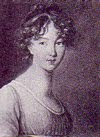This quilt mixes two collections, the Sarah Johnson quilt
from the Shelburne Museum in Vermont, and the Copp quilt from Stonington,
Connecticut, now in the Smithsonian Museum in Washington, DC.
Both lines were from RJR Fabrics in the mid-1990s, and came in
multiple colourways. The Sarah Johnson line had thirty-three designs in ten
prints. Six of them were from the quilt itself and the others were based on
late 18th and 19th century quilts. Undulating stripes,
two-tone prints, scrollwork, foliage, feathers, florals, chintz and geometrics
were featured. The Copp line was based on prints and a quilt in the Copp
Collection of Goods and Textiles which were donated to the Smithsonian Museum
in 1890 by J.B. Copp. There were eleven prints in three colourways, featuring
brocades, florals, stripes, garlands, vines, and geometrics.
The original quilts and prints have fascinating stories.
Sarah Johnson was a fourteen-year old girl and quite proficient when she made
the quilt in 1826. The Copp donation to the Smithsonian was the beginning of
its quilt collection; amongst the textiles, clothing and furniture were three
quilts. The Copp quilt is dated between 1795 and 1815. These quilts and collections have been
written about in various publications about quilting and I am indebted to
issues of Quiltiques (February,
May/June, and September, all from 1996) for jogging my memory.
When I made this quilt, I laid out all of the triangles on
the floor and left them there for a few months. It was the best way to make
sure I was happy with the balance of the prints. There were days when I didn’t even look at them but I liked
to think that I was noticing them subliminally. Because the top of the quilt is
so busy, I chose a solid green backing. The outer borders are rectangles of the same
prints with a knife edge. I just couldn’t get enough of them, I guess!
The quilt measures an odd 61” x 56”, and is entirely hand
pieced and hand quilted.








